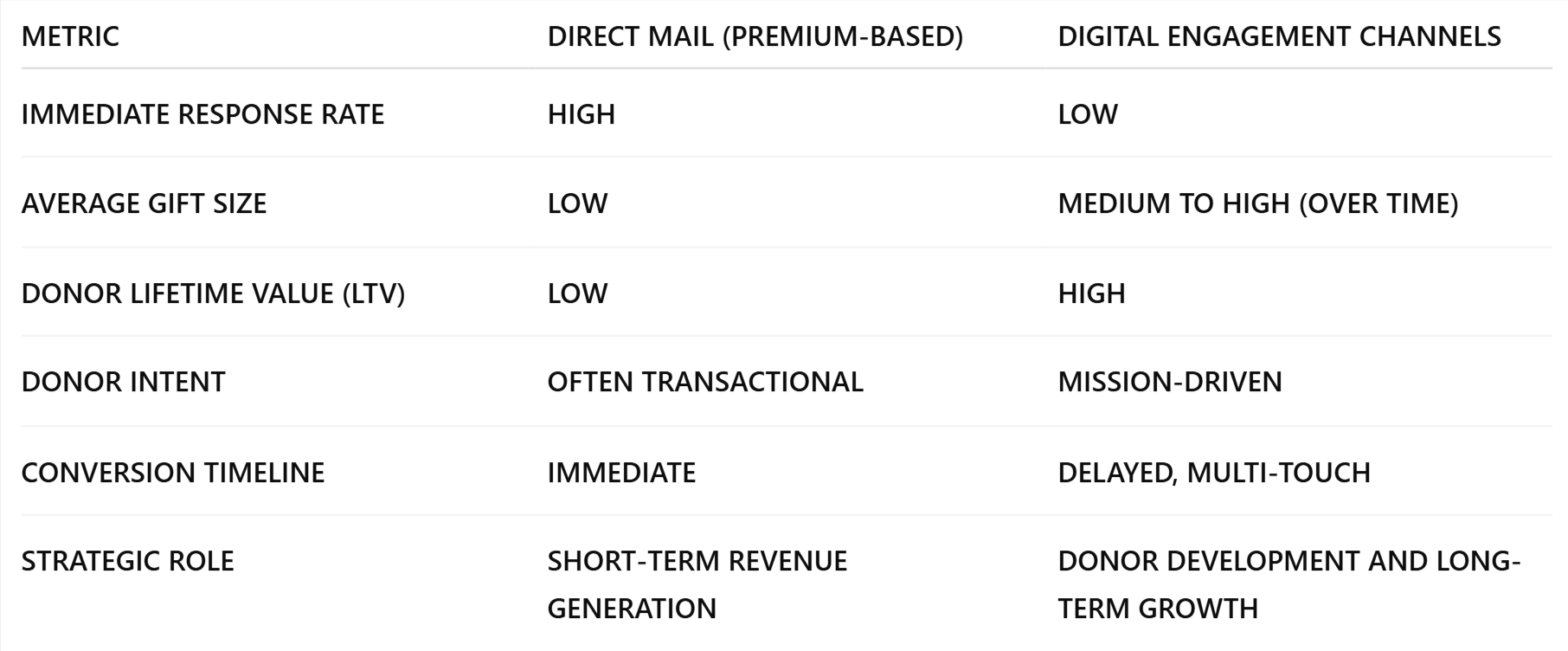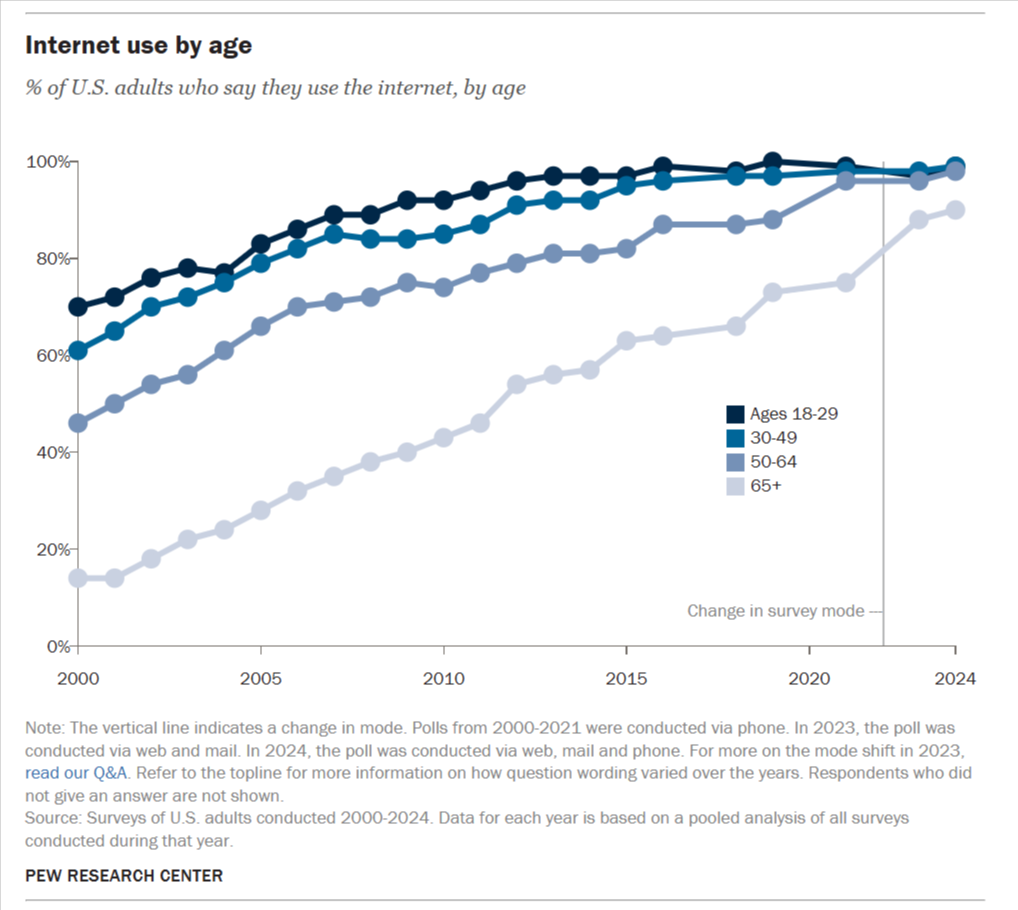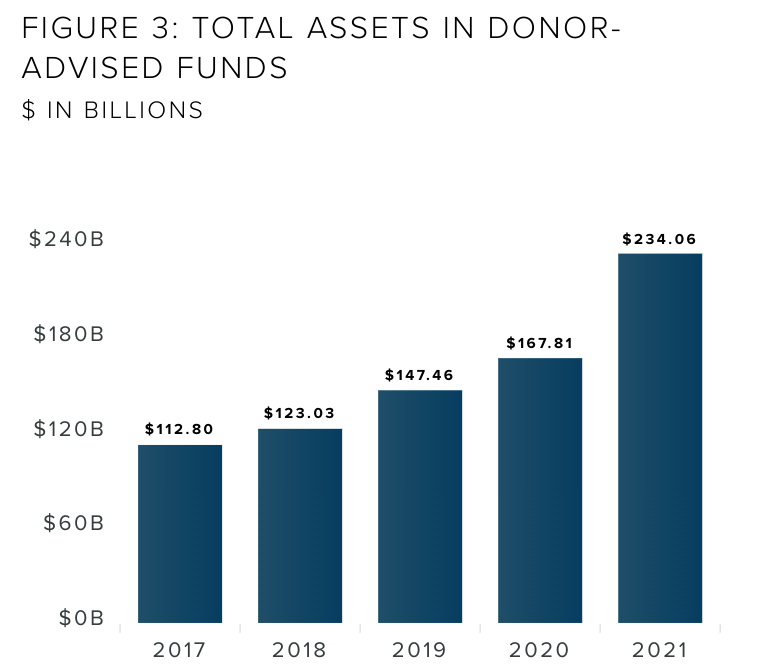Nonprofits today use a wide range of channels to reach potential supporters. These include Google Ad Grants, email newsletters, social media, digital content, websites, and direct mail. One of the most common mistakes organizations make is evaluating all of these tools using the same success metrics.
Direct mail, especially appeals that include a premium gift like a t-shirt, tote bag, or return address labels, is often measured by short-term return. How many donations came in? How much was raised? What did it cost to acquire those gifts?
Applying that same lens to digital channels can lead to inaccurate conclusions and underinvestment in tools that build long-term value. Here's why these channels require a different approach.
Direct mail continues to be one of the most effective fundraising tools for many nonprofits. Premium-based appeals, where donors receive something in exchange for a gift, can generate strong response rates.
Key characteristics:
That said, direct mail can absolutely be mission-driven. Appeals that center around powerful stories, impact updates, or emotional calls to action help deepen donor relationships. For many organizations, mission-based mail remains a vital part of the fundraising mix.
Even so, direct mail—whether transactional or mission-oriented—is typically built and evaluated based on immediate response and short-term revenue.
The Digital Engagement Engine
These digital tools serve a fundamentally different purpose. While they do drive donations, their greater value lies in building visibility, trust, and sustained engagement with supporters over time.
Key characteristics:
For example, someone might discover your organization through a Google search, engage with educational content on your website, follow you on social media, join your email list, and become a donor later. That journey may take months or years. If you only track immediate donations, you will miss the true value of these channels.
Click Image For Larger View

When all channels are judged by the same short-term metrics, organizations risk undervaluing the very tools that grow the donor base and build meaningful loyalty. These are the channels that open the door to larger, more transformative gifts.
Digital engagement, including website experiences and mission-aligned content, plays a critical role in:
All of this begins with clear, mission-focused communication and a consistent digital presence.
Click Image For Larger View

It’s a myth that only younger donors use digital. People of all ages are online—and your prospects and donors are already looking you up.
Whether they find you through Google, Facebook, Instagram, LinkedIn, or a forwarded email, one thing is certain:
They’re judging your organization based on what they see.
That includes:
A strong digital experience doesn’t just lead to online donations.
The even bigger opportunity is that it increases confidence, builds trust, and inspires giving through other traditional channels like direct mail, foundation checks, bequests/trusts, donor-advised funds, and even corporate or event sponsorships.
When people are shown a professional, emotionally resonant digital experience, they’re more likely to give—and give more.
That’s how great digital presence opens up new revenue streams and strengthens performance across your full fundraising strategy.
All channels are valuable, but not all channels should be measured the same way.
Mission-driven direct mail remains a core part of nonprofit fundraising, especially for generating short-term support. At the same time, digital tools like Google Ad Grants, email, social media, digital content, and your website are essential for nurturing long-term donors and expanding reach.
They may not produce immediate returns, but they lead to deeper relationships, larger gifts, and stronger lifetime value.
The most effective organizations recognize the unique role each channel plays and invest accordingly in both short-term results and long-term growth.
If you want to see how to engage and build relationships to increase your nonprofit's fundraising revenue streams, book a complimentary meeting with our strategy team.
The world of philanthropy is evolving, and with it, the ways in which donors choose to support their favorite nonprofit organizations. One important shift in this space has been the rise of donor-advised funds (DAFs). DAFs have become an increasingly popular vehicle for charitable giving, and for good reason. In this blog post, we will explore what a donor-advised fund is and why it's of growing importance for nonprofits.
A donor-advised fund is a philanthropic giving vehicle administered by a public charity or a sponsoring organization, like a community foundation such as The New Community Trust or a financial institution like Fidelity Charity or Morgan Stanley (MS GIFT). The donor makes an irrevocable contribution to the fund, receives an immediate tax deduction, and then recommends grants to qualified nonprofit organizations over time. DAFs enable donors to streamline their charitable giving, allowing them to make a single contribution to the fund and then distribute grants to multiple charities without the administrative burden of setting up a private foundation.

DAFs provide an attractive option for potential donors to get involved in philanthropy. By simplifying the giving process and offering tax advantages, DAFs can encourage more people to support nonprofits. As a result, nonprofits have a greater pool of prospective donors to tap into, which can lead to increased funding and long-term sustainability.
Donors who use DAFs tend to be more consistent in their giving. This is because they have already committed their funds to the DAF and are looking for opportunities to make grants to nonprofits. This consistency can provide nonprofits with a reliable source of funding, helping them plan and execute their programs more effectively.
When donors contribute to a DAF, they have the option to invest the funds, potentially allowing their contributions to grow over time. This means that, in some cases, nonprofits could receive more substantial grants from DAFs than they would from one-time direct donations. Furthermore, some DAFs may also provide multi-year support to nonprofits, helping to ensure financial stability and enabling organizations to plan for the future.
By receiving grants from a DAF, nonprofits can avoid some of the administrative tasks associated with managing individual donations. This can save time and resources, allowing organizations to focus on their core mission and programs. In addition, some DAFs may also provide capacity-building support or technical assistance, helping nonprofits strengthen their organizational infrastructure.
DAFs can encourage donors to be more involved in their philanthropy, as they have the opportunity to research and select the nonprofits they wish to support. This active engagement can lead to stronger relationships between donors and nonprofits, fostering a sense of partnership and a shared commitment to the organization's mission.
Donor-advised funds have transformed the philanthropic landscape, offering donors a convenient and efficient way to support the causes they care about. For nonprofits, DAFs represent an essential source of funding, helping to attract new donors, ensure consistent support, and reduce administrative burdens. As the popularity of DAFs continues to grow, nonprofits that understand, leverage and empower DAF fund decision-makers to use these funds will be well-positioned to thrive and make a lasting impact.
If you want to see how to capture donor-advised fund gifts to increase your nonprofit's fundraising revenue streams, book a complimentary meeting with our strategy team.